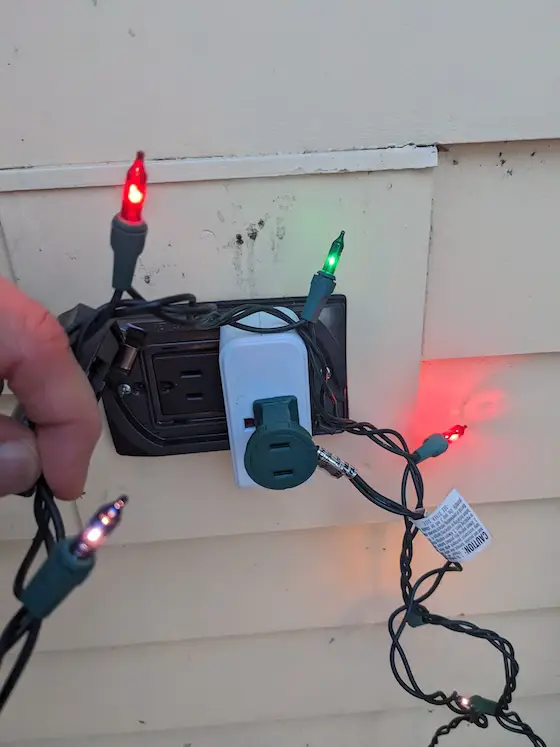Electrical Hacks for Your Home

The odd white rectangle is a smart outlet. It is able to turn on and off via the WiFi in your home allowing you to control when power flows through a cable to lights, a fountain, or any other object powered by electricity. Copyright 2023 Tim Carter
Electrical Hacks for Your Home
Eight months ago a woman hired me to be her virtual general contractor. She was about to start to rebuild a home in remote northern Maine at the south end of Moosehead Lake. She’s the boots-on-the-ground person and we communicate via email, video calls, and texting.
Last week we started to discuss the rough-in electrical work on the large home. She intends to help the rough carpenter install all the boxes and cables. I knew she had never done this work before and I was unsure of the skill level of the carpenter. I’ve come to understand that many tradesmen in that part of Maine are cross-trained in several disciplines. It’s not easy to find skilled labor in a place where the closest road east of the main road leading into town is over 100 miles away!
I decided to share much of my conversation with you in case you plan to build a home soon, build a room addition, or do some remodeling. What you’re about to discover might make your life easier and safer.
It’s important to realize you can wire a house according to all the tenets found in the most recent edition of the National Electrical Code but the wiring job may not be perfect. This code is a standard published by the National Fire Protection Association. It’s all about your safety and reducing insurance losses. Keep in mind that this code, like all building codes, is a set of minimum standards. You can always exceed the requirements of a code.
Early in the discussion with the homeowner, I shared how I had incorporated a simple trick when wiring my daughter’s home four years ago. She lives in Downeast Maine where wicked Nor’easters cause frequent power outages. Having been through quite a few of these myself in central New Hampshire, I know that one of the most miserable aspects is the lack of lighting in an outage.
Did you know you can safely wire the light fixtures in your home on a few separate dedicated circuits? When the power goes out and your generator starts up, you can have light in all or many rooms. Lights don’t draw that much power and you’ll stop using flashlights or dangerous candles.
The woman and I next discussed the gauge of the wire in her new home. I suggested she consider using nothing but 12-gauge wire for all the normal circuits. In her case, it would cost less than $400 for this invaluable upgrade. Twelve-gauge wire is rated for 20 amps giving you an abundance of power on circuits that normally would be strained or pop the breaker when you plug in a tool such as a table saw.
I then shared all sorts of stories about how electricians and homeowners don’t think through the placement of switches and outlets. For example, my lovely wife is left-handed. She holds her hair dryer with her right hand and brushes her hair with her left hand. Placing the outlet on the right side of the sink prevents the dryer cord from crossing over the sink.
Next up I told her about my son-in-law’s command-center closet in the entrance hall of his home. This turned out to be a perfect place to hide his WiFi router, Internet modem and the controls for his interior sound speakers spread throughout the house. We placed outlets up high in strategic locations where we knew the electrical equipment would be on shelves.
I also installed three blank 1-inch-diameter conduits from the basement up into the closet terminating in blank 4-inch-square boxes. This allowed the cable TV technician to run his cables with ease. It also allows for fiber optic cables to be installed in minutes when it becomes available.
My son-in-law and I also installed two extra circuits in his attic and two down in his basement. The junction boxes were out in the open as required by code. Can you imagine how happy a future homeowner will be to discover they already have power installed for some future purpose? It took less than one hour to install all four of these circuits.
You may love to do holiday lighting but dread having to deal with the extension cords that might snake all across your lawn and the front of your home. I’ll bet you grumble each autumn wondering why an electrician didn’t install boxes at key locations. Imagine having a few switches inside your home that allow you to turn on and off outdoor lights without having to go outdoors on a cold night to plug in an extension cord.
The switching problem was solved several years ago with smart outlets. These very handy devices allow you to control outdoor and indoor power without having to use the old-fashioned timers. Smart outlets work via your WiFi and an app on your smartphone. You can program each outlet to follow different on-and-off schedules. Smart light bulbs are also available that do the same thing.
Think about all the things in your home you wish the electrician had done differently. I’d love to hear back from you. I can share your complaints in my latest book all about things your builder and subcontractors forgot to do. Just visit my Ask Tim page at www.AsktheBuilder.com to share your story.
Column 1538
2 Responses to Electrical Hacks for Your Home